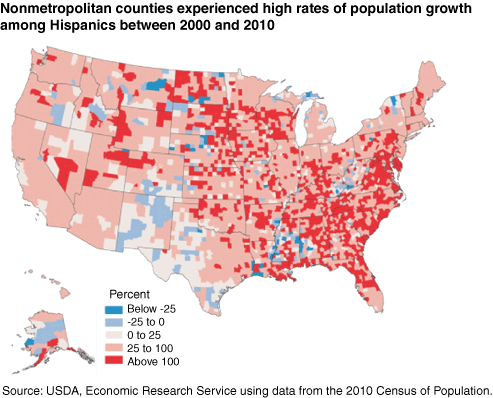Hispanics Contribute to Increasing Diversity in Rural America
- by John Cromartie
- 12/1/2011
During a decade of diminished population growth across rural and small-town America, Hispanic population growth and geographic dispersion during 2000-2010 was a strong driver of demographic change, as it has been for at least two decades. According to census data released in 2011, just over 51 million people lived in U.S. nonmetro counties in April 2010. Between April 2000 and 2010, the nonmetro population added 2.2 million people, less than half that added during the 'rural rebound' of the 1990s.
While the overall nonmetro population grew 4.5 percent in the 2000s, the nonmetro Hispanic population increased 45 percent. And Hispanic population growth was not confined to areas with large Hispanic concentrations in the Southwest. On a percentage basis, growth was significantly higher throughout much of the Southeast, Midwest, and Northwest, as it was during the 1990s.
The nonmetro population as a whole became more geographically concentrated during 2000-2010, with populations shifting away from very rural, isolated settings toward more densely settled and more metro-accessible counties. Population declined by 1.3 percent in the 433 nonmetro counties that were not adjacent to any metro area and that did not include any urban area of 2,500 or more people, but it grew by 6.9 percent in nonmetro counties containing cities of 20,000 or more people (whether adjacent or not).
At the same time, population dispersion was much more prevalent among nonmetro Hispanics. Their population grew by 42 percent in the 433 completely rural, nonadjacent counties, just a few percentage points below the 46-percent rate for Hispanics in highly urbanized counties.
Hispanic populations more than doubled in most nonmetro counties in the South and in many otherwise slow-growing or declining sections of the Nation's Heartland. In 228 nonmetro counties, overall population loss was avoided because Hispanic population growth more than offset non-Hispanic population decline. In many of these otherwise-declining nonmetro counties, Hispanic population growth was fueled by demand for low-skilled food-processing and manufacturing workers during the 2000s. However, expanding service-sector jobs also attracted Hispanics into scenic areas in the West and elsewhere, where Hispanic inmigration was linked with population growth among retirees and other amenity-seeking migrants. These new settlement patterns increase the visibility of Hispanics in many new regions of rural America whose population has long been dominated by non-Hispanic Whites.
This article is drawn from:
- Atlas of Rural and Small-Town America. (2013). ERS. The Atlas of Rural and Small-Town America assembles statistics on four broad categories of socioeconomic factors: People: Demographic data from the latest American Community Survey, including age, race and ethnicity, migration and immigration, education, household size and family composition. Data have been added on veterans, including service period, education, unemployment, income, and demographic characteristics. Jobs: Economic data from the Bureau of Labor Statistics and other sources, including information on employment trends, unemployment, industrial composition, and household income. Agriculture: Indicators from the latest Census of Agriculture, including number and size of farms, operator characteristics, off-farm income, and government payments. County classifications: The rural-urban continuum, economic dependence, persistent poverty, population loss, and other ERS county codes..


